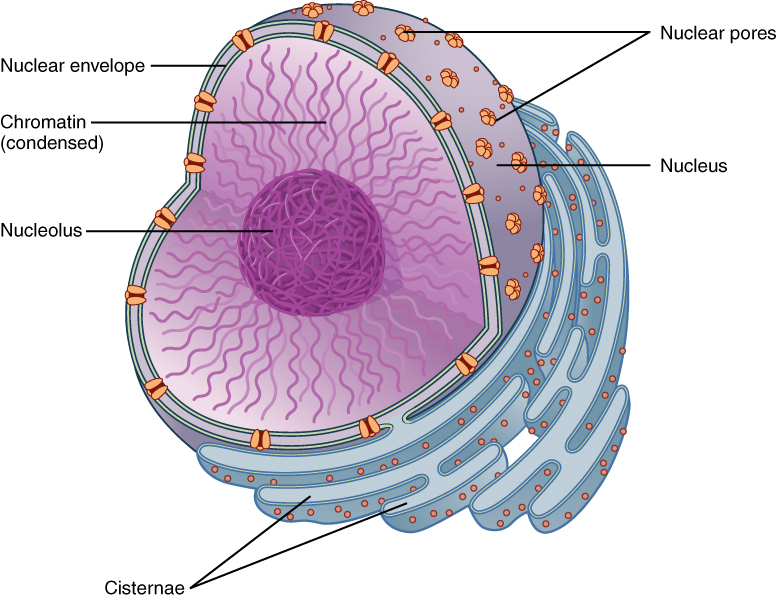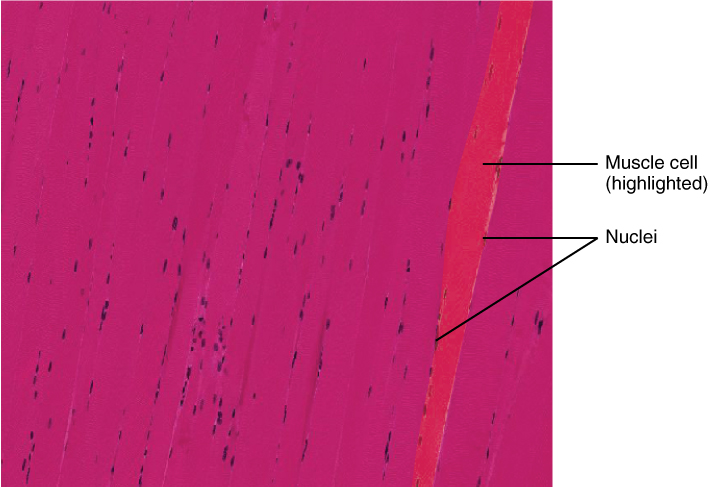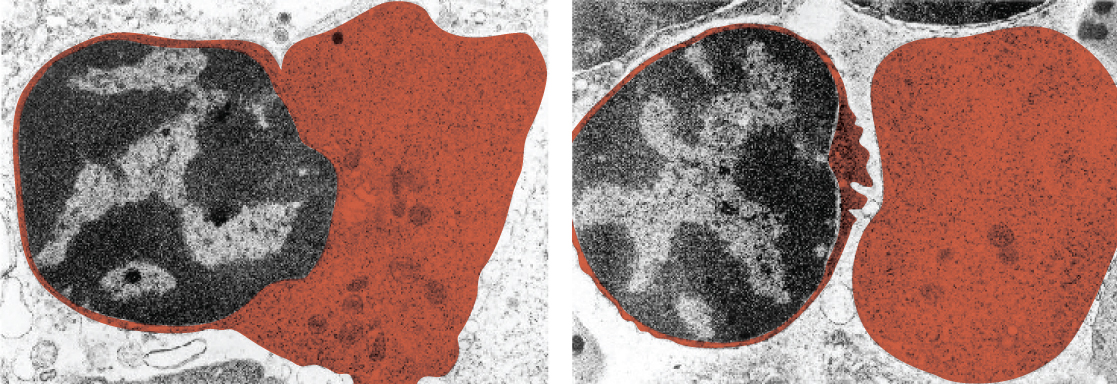2.4: The Nucleus
- Page ID
- 61518
- Describe the structure and features of the nuclear membrane
- List the contents of the nucleus
- Explain the organization of the DNA molecule within the nucleus
- Describe the process of DNA replication
The nucleus is the largest and most prominent of a cell’s organelles (Figure \(\PageIndex{1}\)). The nucleus is generally considered the control center of the cell because it stores all of the genetic instructions for manufacturing proteins. Interestingly, some cells in the body, such as muscle cells, contain more than one nucleus (Figure \(\PageIndex{2}\)), which is known as multinucleated. Other cells, such as mammalian red blood cells (RBCs), do not contain nuclei at all. RBCs eject their nuclei as they mature, making space for the large numbers of hemoglobin molecules that carry oxygen throughout the body (Figure \(\PageIndex{3}\)). Without nuclei, the life span of RBCs is short, and so the body must produce new ones constantly.



View the University of Michigan WebScope at 141.214.65.171/Histology/Basi....svs/view.apml to explore the tissue sample in greater detail.


View the University of Michigan WebScope at virtualslides.med.umich.edu/H....svs/view.apml to explore the tissue sample in greater detail.
Inside the nucleus lies the blueprint that dictates everything a cell will do and all of the products it will make. This information is stored within DNA. The nucleus sends “commands” to the cell via molecular messengers that translate the information from DNA. Each cell in your body (with the exception of germ cells) contains the complete set of your DNA. When a cell divides, the DNA must be duplicated so that the each new cell receives a full complement of DNA. The following section will explore the structure of the nucleus and its contents, as well as the process of DNA replication.
Chapter Review
The nucleus is the command center of the cell, containing the genetic instructions for all of the materials a cell will make (and thus all of its functions it can perform). The nucleus is encased within a membrane of two interconnected lipid bilayers, side-by-side. This nuclear envelope is studded with protein-lined pores that allow materials to be trafficked into and out of the nucleus. The nucleus contains one or more nucleoli, which serve as sites for ribosome synthesis. The nucleus houses the genetic material of the cell: DNA. DNA is normally found as a loosely contained structure called chromatin within the nucleus, where it is wound up and associated with a variety of histone proteins. When a cell is about to divide, the chromatin coils tightly and condenses to form chromosomes.
There is a pool of cells constantly dividing within your body. The result is billions of new cells being created each day. Before any cell is ready to divide, it must replicate its DNA so that each new daughter cell will receive an exact copy of the organism’s genome. A variety of enzymes are enlisted during DNA replication. These enzymes unwind the DNA molecule, separate the two strands, and assist with the building of complementary strands along each parent strand. The original DNA strands serve as templates from which the nucleotide sequence of the new strands are determined and synthesized. When replication is completed, two identical DNA molecules exist. Each one contains one original strand and one newly synthesized complementary strand.
Review Questions
Q. The nucleus and mitochondria share which of the following features?
A. protein-lined membrane pores
B. a double cell membrane
C. the synthesis of ribosomes
D. the production of cellular energy
Answer: B
Q. Which of the following structures could be found within the nucleolus?
A. chromatin
B. histones
C. ribosomes
D. nucleosomes
Answer: C
Glossary
- chromatin
- substance consisting of DNA and associated proteins
- chromosome
- condensed version of chromatin
- DNA polymerase
- enzyme that functions in adding new nucleotides to a growing strand of DNA during DNA replication
- DNA replication
- process of duplicating a molecule of DNA
- genome
- entire complement of an organism’s DNA; found within virtually every cell
- helicase
- enzyme that functions to separate the two DNA strands of a double helix during DNA replication
- histone
- family of proteins that associate with DNA in the nucleus to form chromatin
- nuclear envelope
- membrane that surrounds the nucleus; consisting of a double lipid-bilayer
- nuclear pore
- one of the small, protein-lined openings found scattered throughout the nuclear envelope
- nucleolus
- small region of the nucleus that functions in ribosome synthesis
- nucleosome
- unit of chromatin consisting of a DNA strand wrapped around histone proteins


